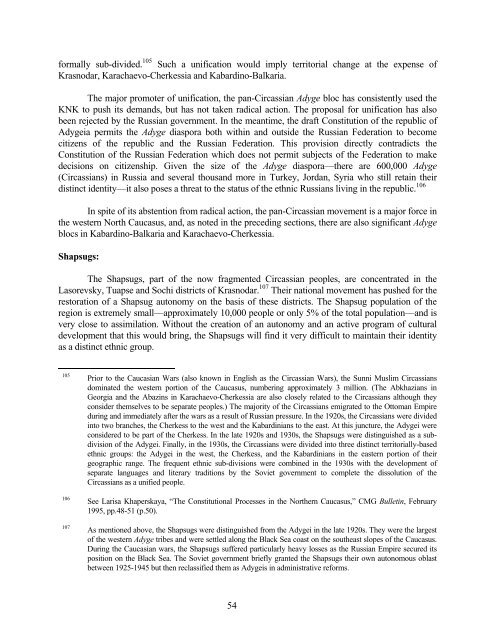RUSSIA'S TINDERBOX - Belfer Center for Science and International ...
RUSSIA'S TINDERBOX - Belfer Center for Science and International ...
RUSSIA'S TINDERBOX - Belfer Center for Science and International ...
You also want an ePaper? Increase the reach of your titles
YUMPU automatically turns print PDFs into web optimized ePapers that Google loves.
<strong>for</strong>mally sub-divided. 105 Such a unification would imply territorial change at the expense of<br />
Krasnodar, Karachaevo-Cherkessia <strong>and</strong> Kabardino-Balkaria.<br />
The major promoter of unification, the pan-Circassian Adyge bloc has consistently used the<br />
KNK to push its dem<strong>and</strong>s, but has not taken radical action. The proposal <strong>for</strong> unification has also<br />
been rejected by the Russian government. In the meantime, the draft Constitution of the republic of<br />
Adygeia permits the Adyge diaspora both within <strong>and</strong> outside the Russian Federation to become<br />
citizens of the republic <strong>and</strong> the Russian Federation. This provision directly contradicts the<br />
Constitution of the Russian Federation which does not permit subjects of the Federation to make<br />
decisions on citizenship. Given the size of the Adyge diaspora—there are 600,000 Adyge<br />
(Circassians) in Russia <strong>and</strong> several thous<strong>and</strong> more in Turkey, Jordan, Syria who still retain their<br />
distinct identity—it also poses a threat to the status of the ethnic Russians living in the republic. 106<br />
In spite of its abstention from radical action, the pan-Circassian movement is a major <strong>for</strong>ce in<br />
the western North Caucasus, <strong>and</strong>, as noted in the preceding sections, there are also significant Adyge<br />
blocs in Kabardino-Balkaria <strong>and</strong> Karachaevo-Cherkessia.<br />
Shapsugs:<br />
The Shapsugs, part of the now fragmented Circassian peoples, are concentrated in the<br />
Lasorevsky, Tuapse <strong>and</strong> Sochi districts of Krasnodar. 107 Their national movement has pushed <strong>for</strong> the<br />
restoration of a Shapsug autonomy on the basis of these districts. The Shapsug population of the<br />
region is extremely small––approximately 10,000 people or only 5% of the total population––<strong>and</strong> is<br />
very close to assimilation. Without the creation of an autonomy <strong>and</strong> an active program of cultural<br />
development that this would bring, the Shapsugs will find it very difficult to maintain their identity<br />
as a distinct ethnic group.<br />
105 Prior to the Caucasian Wars (also known in English as the Circassian Wars), the Sunni Muslim Circassians<br />
dominated the western portion of the Caucasus, numbering approximately 3 million. (The Abkhazians in<br />
Georgia <strong>and</strong> the Abazins in Karachaevo-Cherkessia are also closely related to the Circassians although they<br />
consider themselves to be separate peoples.) The majority of the Circassians emigrated to the Ottoman Empire<br />
during <strong>and</strong> immediately after the wars as a result of Russian pressure. In the 1920s, the Circassians were divided<br />
into two branches, the Cherkess to the west <strong>and</strong> the Kabardinians to the east. At this juncture, the Adygei were<br />
considered to be part of the Cherkess. In the late 1920s <strong>and</strong> 1930s, the Shapsugs were distinguished as a subdivision<br />
of the Adygei. Finally, in the 1930s, the Circassians were divided into three distinct territorially-based<br />
ethnic groups: the Adygei in the west, the Cherkess, <strong>and</strong> the Kabardinians in the eastern portion of their<br />
geographic range. The frequent ethnic sub-divisions were combined in the 1930s with the development of<br />
separate languages <strong>and</strong> literary traditions by the Soviet government to complete the dissolution of the<br />
Circassians as a unified people.<br />
106 See Larisa Khaperskaya, “The Constitutional Processes in the Northern Caucasus,” CMG Bulletin, February<br />
1995, pp.48-51 (p.50).<br />
107 As mentioned above, the Shapsugs were distinguished from the Adygei in the late 1920s. They were the largest<br />
of the western Adyge tribes <strong>and</strong> were settled along the Black Sea coast on the southeast slopes of the Caucasus.<br />
During the Caucasian wars, the Shapsugs suffered particularly heavy losses as the Russian Empire secured its<br />
position on the Black Sea. The Soviet government briefly granted the Shapsugs their own autonomous oblast<br />
between 1925-1945 but then reclassified them as Adygeis in administrative re<strong>for</strong>ms.<br />
54
















